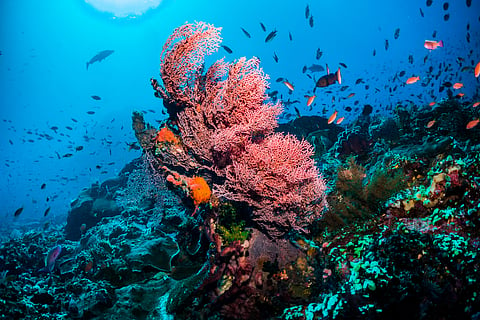

Two cyclones, flooding and extreme heat during the summers have caused significant losses of the corals on the northern Great Barrier Reef.
Fresh data from the Australian Institute of Marine Science’s (AIMS) by in-water surveys has revealed that coral cover has declined on 12 of 19 reefs surveyed between Lizard Island and Cardwell post the extreme weather reported in summer between December 2023 and March 2024.
Surveys carried out by AIMS’ Long Term Monitoring Program (LTMP) between August and October 2024 revealed a significant loss of coral cover on 12 reefs varying between 11 per cent and 72 per cent compared to pre-summer levels.
In a press statement issued by the Australian government, the scientists said, “More than a third of hard coral cover was lost across the Cooktown-Lizard Island sector (from the recorded high of 31.4 per cent a year ago to 19.3 per cent), which is the largest annual decline for this sector in 39-years of AIMS’ monitoring.”
Hard coral cover is a measure of the percentage of live coral on the reef surface.
Coral bleaching is often observed due to heat stress experienced by the corals. Bleaching involves corals expelling tiny algae from its tissues owing to stress turning them into white. Prolonged bleaching or severe stress may turn fatal and lead to mass death of corals.
The assessment is the first of the impacts of the fifth mass coral bleaching experienced by the Great Barrier Reef and fourth mass coral bleaching event in the world.
The ongoing global coral bleaching is the widest and most severe bleaching event with nearly 77 per cent of the global reefs experiencing bleaching level heat stress over the past 20 months.
The Long-Term Monitoring Program (LTMP) shows that the coral cover in the Cairns sector declined by more than a third across five reefs assessed so far. In the Innisfail sector, the corals were reportedly less damaged with cover similar to pre-summer levels.
Scientists expect to survey another 10 reefs in coming months, along with some others in the Cooktown-Lizard Island sector.
Mike Emslie, AIMS’ LTMP in-charge stated that the amount of coral loss implied the exposure of reefs to the multiple weather disturbances.
“During February and March 2024, all the reefs we recently surveyed in this north Queensland region were subjected to levels of climate change-driven heat stress that cause bleaching. The heat stress got so high in some areas that mortality is not a surprising outcome. Tropical Cyclones Jasper and Kirrily also exposed many to wave heights likely to cause damage to corals, generally greater than four metres,” he stated.
Moreover, aerial surveys have been conducted by authorities over 1080 reefs across the GBR with 73 per cent of bleaching, highest observed in Marine Park.
“Very high (61-90% coral cover bleached) and extreme bleaching (>90% coral cover bleached) was observed on 39% of surveyed reefs within the Marine Park, occurring in all three regions but to concentrated in most of the southern and parts of the central and northern regions,” the results noted.
The authorities expect the full assessment of the corals across the Marine Park to complete by mid-2025.
Furthermore, the inner and mid-shelf reefs in the Cooktown-Lizard island reported more impacts from the bleaching caused by extreme heat with the inner shelf reef experiencing almost 75 per cent loss of pre-summer hard coral cover.
On the contrary, outer shelf reefs showed minimum or no coral loss. The impacts varied according to coral types. The most commonly reported mortality was among the Acropora species.
“This fast-growing coral has been partly responsible for the recent recovery on the Reef but is also susceptible to the kind of disturbance events we’ve seen this summer. Other coral types, such as branching Acropora were less affected, while massive corals – like Porites - were least affected. This points to the variability and dynamics on coral reefs,” the scientists noted.
The officials said that the initial results underline the vulnerability of the reef and that its resilience is being pushed to limits with increasing frequency and intensity of bleaching events.